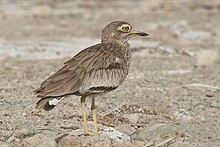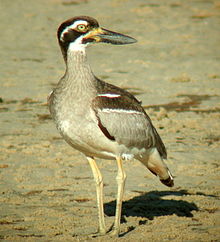Triele
| Triele | ||||||||||
|---|---|---|---|---|---|---|---|---|---|---|

Triel ( Burhinus oedicnemus ) |
||||||||||
| Systematics | ||||||||||
|
||||||||||
| Scientific name | ||||||||||
| Burhinidae | ||||||||||
| Mathews , 1912 |
The triele (Burhinidae) are a family of plover-like . These are mostly inconspicuously colored birds that live on the ground in open landscapes of all continents with the exception of Antarctica . There are nine species in two genera , one of which is also native to Europe , the common triel .
features
Triele are medium-sized birds with strong legs, strong bills and long, pointed wings. The body length is between 32 cm (Senegal Triel) and 59 cm (Long-tailed Triel). The plumage of the species of the genus Burhinus is sand-colored and covered with brown or black spots or stripes. Only in the Perutriel this pattern is not available, so that the bird looks more monochrome. The underside is even paler in color. The Esacus species have an unstriped gray top. More conspicuous are the wings, which are noticeable in Burhinus with black hand wings with white spots, in Esacus they are white. A sexual dimorphism does not exist.
The legs, which are ocher brown to yellow, are characterized by a clearly thickened intertarsal joint , hence the English name thick-knees (= thick knee, although anatomically it is not a knee). The three toes of the feet are connected with a short tension skin, one rear toe is missing ( tridactyly ). The beak is strong, in Burhinus it is relatively stout and comparatively short, in Esacus it is considerably wider and longer. Mostly it is black in color and yellow at the base. The large eyes with mostly yellow irises are characteristic. The tail is short and rounded in Burhinus and rectangular in Esacus .
Triele have a large repertoire of whistling and plaintive sounds, which are very variable from species to species as well as within the species. Numerous local names arose due to characteristic calls, such as the English name of the European triel ( stone-curlew ), as well as regional names for the perutriel ( huerequeque ) and the long-tailed triel ( willaroo ).
distribution and habitat
Triele are common on all continents except Antarctica, but not without gaps. The distribution area is densest in Africa. Only in Europe and in western Central Asia do Triele occur in the northern temperate zone. In addition, South Asia and Australia are settled, but only relatively small areas in the tropics on the American double continent. The habitat is always open terrain and never forest. Depending on the species, however, completely different types of open habitats are populated; while some deserts, semi-deserts and savannahs, others prefer river banks and sea coasts.
As a rule, triels are resident birds , with the only exception of the European triel, whose northern populations are migratory birds .
Way of life
Triele are predominantly ground-dwelling birds that run rather than fly when threatened. With the exception of the Reef Triel, they are crepuscular and nocturnal. They spend the day crouching on the ground, often in the shade of bushes or trees. Outside the breeding season, they are quite social birds, forming small groups of a few dozen to a few hundred individuals. However, the number of individuals in these associations has become significantly smaller in many places due to the collapse of the population.
nutrition
Food is picked from the bottom while walking. In all species, invertebrates dominate, especially insects, in the coastal species crabs. The reef triel (but not the crab triel) lives almost exclusively on crabs and other crustaceans. Small vertebrates such as rodents, frogs and lizards, as well as bird eggs, are also eaten to a lesser extent, although it is not surprising that it is the larger species of Triel in particular that eat this prey.
Reproduction
Triele live in seasonal or lifelong monogamy . During the breeding season the associations dissolve and the pairs remain alone; only when habitat is scarce do several pairs breed in relative proximity to each other. The nest is usually built in very open terrain without any external protection, only the long-tailed triel breeds in the protection of bushes. It consists of a scratched-out recess in the ground, which is sometimes not covered at all, but mostly with stones, shells or animal dung. A special feature is the preference of the water triel to create this nest in dried excrement, for example elephant dung.
The reef triel lays a single egg, all other species lay two and only in very rare exceptional cases three eggs. The size is between 4.9 × 3.2 and 6.5 × 4.5 centimeters. The eggs are whitish or beige and covered with brown spots, which guarantees good camouflage on the ground. Both parents incubate for 24 to 27 days.
The young are refugees . They are accompanied by their parents for six to seven weeks before they are fully fledged. They protect themselves from predators by crouching motionless on the ground and relying on their camouflage. The parent birds try to lure predators away from the young, in acute danger they try to make the attacker flee with threatening gestures. Triele become sexually mature at the age of two to three years.
Tribal history
The oldest known fossils of Trielen come from the late Oligocene of Europe and Australia.
Systematics
Because of external similarities, triele were once placed near the bustards . Today, however, because of the features of the skeleton, the appearance of the young and the common parasites, there is no doubt that they belong to the plover-like species . The closest relatives within this order are still a mystery. In addition to the plovers , the egret runner , crocodile watcher , curlew-like and avocet were discussed.
The Triele family comprises 2 genera and 9 species:
-
Burhinus
- Dominican triel ( Burhinus bistriatus )
- Kaptriel ( Burhinus capensis )
- Long-tailed Triel ( Burhinus grallarius )
- Triel or European Triel ( Burhinus oedicnemus )
- Senegal triel ( Burhinus senegalensis )
- Perutriel ( Burhinus superciliaris )
- Water triel ( Burhinus vermiculatus )
-
Esacus
- Reef triel ( Esacus magnirostris )
- Crab Triel ( Esacus recurvirostris )
Occasionally all species were assigned to the genus Burhinus , so that there is only one genus. On the other hand, the reef triel was sometimes placed in its own genus Orthorhampus , increasing the number of genera to three. The scientific name Burhinus magnirostris was also common for the long-tailed triel . This leads to an identical name with the reef triel ( Esacus magnirostris ), if this is also placed in the genus Burhinus . Therefore, several alternative names for the reef triel have been suggested. Meanwhile, the accepted name for the long-tailed triel is Burhinus grallarius , as John Latham coined both this name and Burhinus magnirostris at the same time because he considered populations of the long-tailed triel to be different species.
People and Triele
Because of their nocturnal way of life, triele do not play a major role in human folklore. There are few interrelationships. In Africa, the Senegal Triel is a cultural follower, so numerous couples breed on rooftops in Cairo .
At the species level, no species is threatened with extinction. The coast-dwelling species of the genus Esacus are both listed by the IUCN as "potentially endangered".
Even if none of the species is threatened overall, there are worrying population declines in individual regions. The situation in Australia is particularly dramatic here , where numerous habitats have become pastures, so that ungulates are now trampling on the clutches of the triele. Triele are also preyed on by introduced predators such as cats and foxes. Triele have completely disappeared from numerous more densely populated regions of the continent; the long-tailed triel is completely extinct in Tasmania . On the coasts of Australia it is intensive use by bathers and water sports enthusiasts who have driven the reef triel from these habitats.
Names
The German name Triel, which was originally only applied to the European species, is probably onomatopoeic for the reputation of this species. In English, the European Triel is called stone-curlew . This name is also onomatopoeic. Curlew is the curlew , whose calls are similar to that of the triel. The entire family is called thick-knees after the thickened intertarsal joint, which anatomically cannot be mistaken for a bird's knee. The Afrikaans name dikkop (thick head) for the African species is also used in English and refers to the relatively large head.
The scientific name Burhinus , from which the family name Burhinidae is derived, means "ox nose" (Greek bous , ox, and rhis , nose).
literature
- Josep del Hoyo et al .: Handbook of the Birds of the World. Volume 3: Hoatzin to Auks. Lynx Edicions, Barcelona 1996. ISBN 8487334202 .
Individual evidence
- ↑ a b c del Hoyo et al .: HBW Volume 3, Morphological Aspects , pp. 350–352, see literature.
- ↑ a b del Hoyo et al .: HBW Volume 3, Voice , p. 353, see literature.
- ↑ del Hoyo et al .: HBW Volume 3, Habitat , p. 352, see literature.
- ↑ del Hoyo et al .: HBW Volume 3, Movements , pp. 357-358, see literature.
- ↑ del Hoyo et al .: HBW Volume 3, General habits , pp. 352-353, see literature.
- ↑ del Hoyo et al .: HBW Volume 3, Food and feeding , pp. 353-354, see literature.
- ↑ a b c del Hoyo et al .: HBW Volume 3, Breeding , pp. 354-357, see literature.
- ↑ Vanesa L. De Pietri, R. Paul Scofield: The earliest European record of a Stone-curlew (Charadriiformes, Burhinidae) from the late Oligocene of France. In: Journal of Ornithology. 2014, Vol. 155, No. 2, pp. 421-426.
- ↑ a b del Hoyo et al .: HBW Volume 3, Systematics , pp. 348-350, see literature.
- ↑ del Hoyo et al .: HBW Volume 3, Relationship with Man , p. 358, see literature.
- ↑ IUCN Red List of Threatened Species , accessed June 8, 2017.
- ↑ del Hoyo et al .: HBW Volume 3, Status and Conservation , pp. 358-359, see literature.
- ^ Triel on duden.de , accessed on June 8, 2017.
- ↑ James A. Jobling: Helm Dictionary of Scientific Bird Names. A&C Black, 2010, ISBN 9781408125014 , p. 81.



